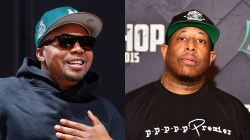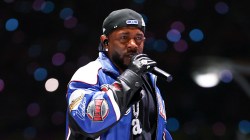Time Is Illmatic, the pioneering documentary of what is arguably the most influential album in Rap history was started by Eric Parker and One9 a decade ago. That’s 10 years of convincing people the reclusive emcee would open up, gathering lost footage, and hoping against unreasonable hope that funding would come from somewhere, somehow. It eventually did, and the rest is right-in-front-of-your-eyes history.
With the film on its inaugural tour, HipHopDX not only had the chance to watch the documentary, but to interview the dreamers behind it. Director One9 and writer Erik Parker connected through their mutual love for Nas’ debut, and with that passion they created a work that they hope survives the test of time. A time they hope will remain Illmatic
Nas’ Father, Olu Dara, Filled The Home With Afrocentric Literature
Nas’ father, Olu Dara, is an intriguing figure with his own musical past. Aside from being the namesake for Nasir Bin Olu Dara Jones (Nas) he was also an important element of his son’s through emotional guidance. Time is Illmatic illuminated even more about the famous jazz musician. Firstly, his name, which Nas shares, means “God is good,” and he was born in Natchez, Mississippi during segregation and the height of the Ku Klux Klan. It is not well known that he was not even the first musician in the gene pool. That distinction dates back to a member of the Nas’ clan belonging to a musical group called The Millerettes. He got out of Natchez by way of the Navy and kept a library in the house which included: The Egyptian Book of the Dead, Tutankhamen, Psychology of the Modern Man, The Autobiography of Malcolm X, Sun Tzu, Eastern Facts About the World, A History of Chinese Philosophy, They Came Before Columbus, Aesop’s Fables, Afrocentricity, The Tao of the King, From Superman to Man, The Bible and Trials and Tribulations of Ghetto Life among others. It is absolutely no surprise, then, that Nas continued his education at home despite dropping out of school in the eighth grade.
How Ill Will’s Death Led To Nas’ Changing & Taking Music Seriously
Long before he dropped out of high school, with his fathers blessing, and began recording his famous album, he had been shaped by experiences and adventures in Queensbridge Housing Projects. Ann Jones cooking was known throughout Queensbridge and she regularly hosted people for dinner. Nas said that she provided, “A beautiful home inside that neighborhood.” Along with the many books, instruments filled the house and after a brief stint with trumpet, Nas began rhyming at the age of 7 according to Jungle and Olu Dara. Nas’ best friend as a youth, Ill Will, got killed after an altercation standing next to Nas’ brother Jabari, or as he was known “Jungle.” During the violence, Nas was in an apartment nearby and afterwards began to think that “life didn’t feel valuable,” or as Olu Dara put it, “Nas got more cynical. He had a little more hurt.” Jungle saw the fallout as well, “Once he died he fully dedicated to the music. We barely saw him.”
“The Bridge” Inspired Nas & “Juicy” Almost Ended Up On Illmatic
When it all started “The Bridge” by Marley Marl was inspirational for Nas and made him think it was possible to make music with a message. “That song changed everything,” said… “Live at the Barbecue” by The Main Source was his first big break at 18 years old. On his guest verse he stood out with lines like, “When I was 12 I went to hell for snuffin’ Jesus.” Within a week everyone was searching for this kid named Nasty Nas and MC Serch finally found him. The album and his career began at Power Play Studios in Queensbridge with Large Professor on the boards.
Illmatic notably begins with “The Genesis” and one of the voices on that prelude is Jungle. According to Nas, “NY State Of Mind” is supposed to give, “That feeling of New York at night time…things like shots going off every night…pregnant ladies trying to smoke crack…dudes late night waiting to rob you and your are just maneuvering your way through that and then the crazy cops coming through…the atmosphere was a mess.” Nas suggested Pete Rock sing the hook to “The World is Yours” and had to convince him to do it because Pete Rock was not into the idea. The famous Illmatic photo from the cover art is from a photo taken with Olu Dara after they hadn’t seen each other in a while and he came through the neighborhood. “One Love,” which was produced by Q-Tip, was recorded in fellow Tribe member Phife Dawgs’ basement, and years before The Notorious B.I.G. spit over “Juicy” it was almost sampled on Illmatic.
Erik Parker & One9 Had No Previous Filmmaking Experience
This was the filmmakers’ first attempt at a documentary or filmmaking of any sort. It took a decade to make the documentary and the idea originally came at the tenth anniversary of Illmatic. Erik Parker was an editor at Vibe and was writing about the 10-year anniversary of the album when he had the realization that, “The print piece isn’t enough to tell the story of this album that defined our generation.” He and One9, who was mainly known for his work as a graffiti artist at the time, did not know Nas before starting the film, though Parker had interviewed him twice while at The Source, they were merely fans. After speaking with One9 they decided, “We just said, let’s try to make a movie about it,” as One9 tells it.
Nasty Nas Was Not Originally On Board With The Project
As the film went on, Nas, who is regarded by many journalists as guarded, began to open up more to the idea as the direction of the film became clearer. “He really was ready to tell his story at this time and place in his life,” said Parker. The Ford Foundation and Tribeca Film Institute were the principal investors in the film and helped make it happen through grants. Much of the old footage came from various original sources such as the mall footage of them rapping which came from a phone call from an unknown source who heard about the project and wanted to help. Interviews with Olu Dara spurred the chronological structure of the doc because of his deep lineage. The film is meant to transcend just the album and represent social issues that still go on today. “It is more than a Hip Hop story, it’s an American story,” said One9. There is bonus footage available with interviews from Nas about each track and every single producer about their mindset while putting together the tracks with both the lyrics and beats.
RELATED: Everything You Need To Know About Wu-Tang Clan’s “A Better Tomorrow” [Editorials]



![Method Man Admits He Didn't Like Drake's "Wu-Tang Forever": "I [Wasn't] Getting On That"](https://hiphopdx.com/wp-content/uploads/2025/12/method-man-drake-wu-tang-forever-remix.jpg?w=250)






“Time is Illmatic” is an incredible piece of work.
“Time is Illmatic” is wack
You are a lowlife piece of shit. This is one of the most intriguing and engaging hip hop documentaries ever made.
anyone has a clue when this will be available for download?